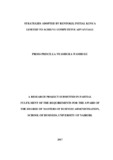| dc.description.abstract | Strategy formulation and implementation is an integral process that an organization has to critical to undertake. An organization should respond the environmental, economic and political changes which affects the efficiency and effectiveness of the strategies. The business functionality of a strategy is to ensure that the firm remains profitable and is successfully sustain its competitive advantage. A strategy is the direct that an organization takes for a long term decision and how it intends to under to get there so as to achieve its objectives. Competition is a healthy trend as it keeps an organization on toes to always aim higher. It makes sure that a firm remains relevant in the industry at all times. Growth has led to increased competition as the pest control industry strives to retain its market share. New and cheap completion from briefcase pest control service providers has made the organization change its dynamics by changing some strategies and formulating others. With this approach, Rentokil Initial has been able to achieve sustainable competitive advantage and has given a competitive edge against their rivals. The study was guided by the objective; to establish strategies used by Rentokil Initial Kenya Limited to achieve sustainable competitive advantage. A case study research design was adopted in this research. Primary data was collected by use of interview guide which seven respondents were interviewed. The findings of the research were critically researched through content analysis. The study revealed that, strategy are positively correlated to sustainable competitive advantage. The study also argued that RBV theory attributed to strategy formulation as it is evident by the different strategies that Rentokil Initial Kenya Limited has put in place. Porter’s (1979) five forces framework is a tool that has been adopted and analysed by the study to show that for a strategy to be successfully implemented, there are key parameters that need to be looked at. The forces include; bargaining power of suppliers, bargaining power of buyers, industry rivalry, threats of substitute and lastly threats of new entrants. The forces we developed to react to swot analysis which it was to apply to address various business to become profitable and stabilization of sustainable competitive advantage. However, there were limitations that occurred during the study. Conducting interviews were a bit problematic as the respondent had busy schedules and others were out of the country. The time taken to fill in the questionnaire, the respondents felt it was too long and some actually thought the study was exposing their strategies to the competitors. Despite the various challenges, the validity of the study still remains accurate and quantitative in nature. The researcher recommends more resources and investments to be segregated for the researches of this manner. The study also emphasized on the need of all stakeholders to be involved in strategy formulation and implementation as will result to high performances of the company revenues and market share. Suggestion for areas of further research for long lasting strategies include the need for a quantitative study on organization structure and strategies implemented by firms. | en_US |



